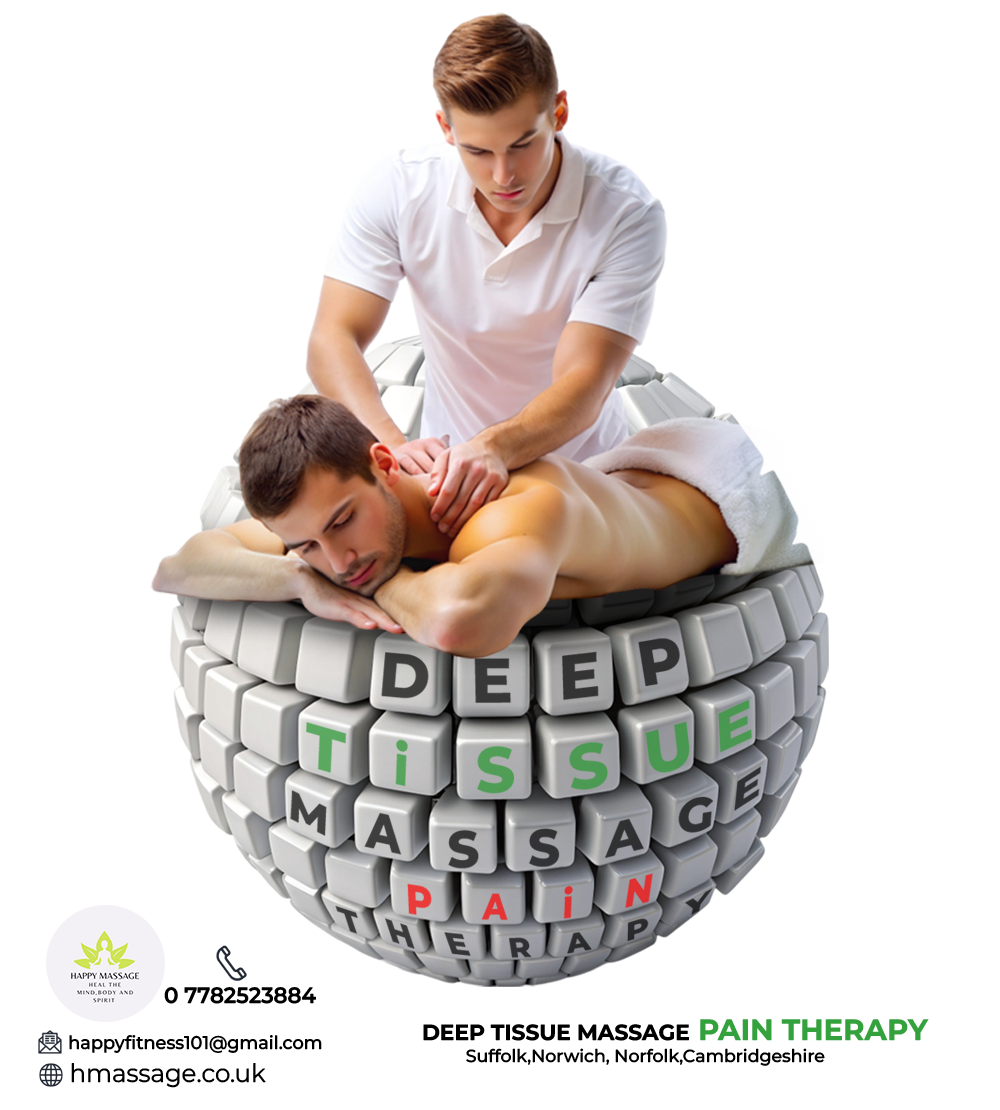As a seasoned massage therapist specialising in deep tissue techniques, I have witnessed firsthand the transformative power of deep tissue massage pain therapy. This therapeutic approach delves beyond the surface to target the inner layers of your muscles and connective tissues.
The massage promotes healing and provides relief from chronic pain. In this blog, I will share insights about Deep Tissue massage Pain Therapy in Suffolk, Norwich, Norfolk, and Cambridgeshire, its benefits and what to expect when you receive this therapy.
Understanding Deep Tissue Massage and its Working :-
Deep tissue massage is not just a standard rubdown. It is a focused, intentional therapy that applies sustained pressure using slow, deep strokes to address tension in the muscles and fascia. The goal is to break up scar tissue and physically break down muscle “knots” or adhesions that can disrupt circulation and cause pain, limited range of motion, and inflammation.
This therapy goes deeper to carve out the underlying problems and manage them accordingly. Only a highly skilful therapist can deliver the therapy optimally without causing any unwanted side effects. So, when you decide to take advantage of this massage, make sure you end up getting this therapy from a person who is well-known and certified.
The Pain-Relief Connection of Deep Tissue Therapy :-
Pain is a signal from our body that something is amiss. It is often rooted in deep-seated tension and chronic patterns of holding stress.
Deep tissue massage works by alleviating these sources of discomfort. While the technique may cause some discomfort during the session, many clients report significant pain relief that continues to improve with subsequent treatments.
5 Wonderful Benefits of Deep Tissue Massage :-
Deep Tissue massage Pain Therapy in Suffolk, Norwich, Norfolk, and Cambridgeshire offers several benefits, particularly for individuals dealing with chronic pain or muscle tension.
Here are five advantages of this therapeutic technique :
[1] Pain Relief :
Deep tissue massage is effective in reducing chronic pain by improving blood flow. The massage also reduces inflammation that causes pain. It can also help relieve tension in tight, strained muscles. For prolonged pain, the application of this therapy can be a wonderful alternative solution.
[2] Stress Reduction :
The massage can trigger the body’s relaxation response, which in turn lowers stress levels. The manipulation of deep tissues releases hormones such as serotonin and oxytocin that promote relaxation and a sense of well-being.
[3] Improved Mobility :
By working on deeper layers of muscle and connective tissue, deep tissue massage can break up scar tissue and adhesions. As a result, it leads to an improved range of motion and flexibility. The therapy also helps correct postural imbalances, reducing strain on the body’s musculoskeletal system.
[4] Lower Blood Pressure :
Studies have shown that deep tissue massage can help lower high blood pressure, thanks to its ability to reduce stress and promote relaxation. When the body becomes active due to the sustained pressure all over the body the brain signals the release of the blood.
[5] Rehabilitation for Injuries :
It is often used to rehabilitate sports injuries, as it can help to stretch tight muscles, stimulate inactive muscles, and improve the condition of the soft tissue. The massage can contribute to a faster recovery by increasing blood flow and reducing inflammation.
What to Expect During a Session :-
A deep tissue massage session is a journey through your body’s landscape of tension. As your therapist, I will begin with lighter pressure to warm up the tissues before moving into the deeper layers.
Communication is key— I encourage feedback to ensure the pressure is effective yet comfortable. After the session, it is normal to experience some soreness, akin to the feeling after a vigorous workout, but this typically subsides within a day or two.
Self-Care Post-Massage to Maximize the Health Benefits :
To maximize the benefits of deep tissue massage, I recommend the following self-care tips :-
(i) Stay Hydrated :
Once you are done with the therapy, you should plenty amount of water. Drinking water helps flush out toxins released during the massage and supports muscle recovery.
(ii) Heat Therapy :
After the massage, you may feel the pressure all over your body. In such cases, applying heat can soothe muscles that may feel tender post-treatment.
(iii) Gentle Stretching :
You should know that stretching is always good for the body’s flexibility. Engaging in light stretching can maintain the increased flexibility gained from the massage.
(iv) Rest :
Since you go through an intensive session, rest is mandatory. You need to allow your body time to heal and integrate the benefits of the session.
Choosing the Right Therapist : Tips to Consider
Selecting a therapist skilled in deep tissue massage is crucial. Look for a licensed professional with specific training in deep tissue techniques and a track record of success in treating pain-related conditions.
Deep tissue massage pain therapy is more than a luxury—it is a vital tool in the quest for pain relief and overall health. By addressing the root causes of pain and tension, this therapy can pave the way for a more active, pain-free life. If you are struggling with chronic pain, consider deep tissue massage as a pathway to recovery and rejuvenation.
At Happy Massage, I ; Mr Happy Harvinder Singh Suwali, provide personalised deep-tissue massage as well as holistic full body deep tissue Swedish massage therapy in Cambridgeshire and surrounding areas.
As an expert in deep tissue massage with years of experience, I am dedicated to helping clients achieve lasting pain relief and improved quality of life. My practice is grounded in the belief that everyone deserves to live without the burden of chronic pain.
Do not subject your body to constant pain, leading to an unhealthy lifestyle. Contact me now to transform your body from fragile to agile !

